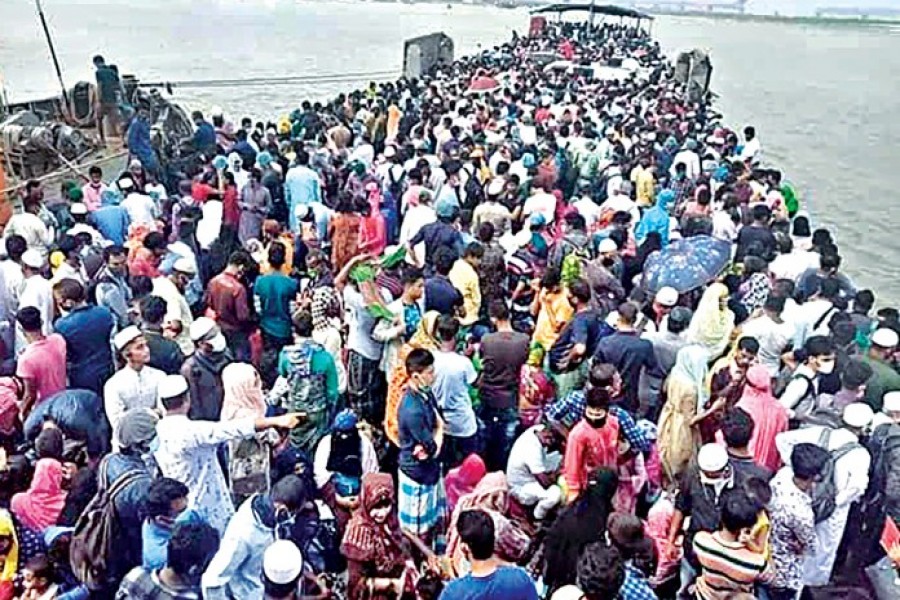Notwithstanding the heritage lovers' taking pride in Dhaka's 400 years of survival, it has yet to achieve the urban features making it eligible to stand beside Kolkata.All big modern citieshave some distinctive urban qualities.
In South Asia, there are a number of bustling cities besides Kolkata. In few of them, there is thepeaceful coexistence of urbanity and the age-old rural characteristics found in Dhaka. Even in the period spanning from the 20thcentury to the present decade of the 21st, Dhaka couldn't sever its umbilical cord from its native villages. In the times of man-made adversities and catastrophes like the killings unleashed by the occupation forces to the ongoing pandemic, the city residents felt unsafe in Dhaka. They feared that they would be betrayed by the 'alien' city. Ironically, many of them have been living in the part-friendly and part-hostile Dhaka for nearly a century. The first option the Dhaka dwellers find open before them in hostile times is the rush for their rural ancestral homesteads.
In normal times, like during the two Eid festivals, a similar scenario is seen being enacted as part of a socio-cultural ritual. It unfolds in the form of a frenzied rush of people for their village homes. To speak dispassionately, like all mechanisedand'lifeless' cities, Dhaka also expects a minimum level of emotional attachment to itby its residents. Unfortunately, they havemiserably failed it.
Inanimate objects, too, are believed to have feelings. The residents of a big city should have to reciprocate the intangible hospitality it gets from a city. As Dhaka grows bigger by the day, though in unwieldy ways, it finds its many residents to be mere strangers.Instead of holding the authorities responsible for the city's many ills, they pour their anger on the very city - which, they believe, cannot function by itself.
In the recent days, Dhaka has once again started watching village-bound exoduses one after another. This time it is being caused by the Covid-19 scare. No sooner had the authorities just begun speculating imposing restrictions on reckless movement and making abiding by health guidelines mandatory than the people began leaving Dhaka. Even in the periods prior to the two consecutive lockdowns, the Dhaka residents were seen being seized by a frenzy of leaving the city. Throwing the directive of maintaining physical distance to the wind, they boarded crammed buses, precariously accommodated open trucks, microbuses and rental cars. Their only goal was reaching their village homes to escape the tentacles of the pandemic.
The three-hundred-year-old Kolkata in the neighbouring Indian state of West Bengal has also been severely hit by the same pandemic. During the last one year, it had to undergo several bouts of lockdown. Surprisingly, except a handful of them, the majority of the Kolkata residents remained stay put. They had long developed an everlasting bond with Kolkata. Their emotional attachment to this historic city has few parallels in the world. The Kolkatans won't object to going through more spells of suffering from Covid-19. Being pure urbanites, they are not prepared to desert their beloved city. Moreover, only a few Kolkatadwellers have their ancestral homes in villages.
Dhaka, however, has a different story. Ever since the emergence of the city as a centre of employment and business, people from rural areas have continued to arrive in Dhaka. It has been going on for ages.
With the passing of time, the ever-growing city has attained the reputation of being an urbancentre, where none remains without an income. Along with it, dozens of myths once filled the air of Dhaka. Some of them included the sayings: Due to the unwavering affluence of the people residing there, starving people are a rare sight in the city. Or, currency notes fly around the whole city. One just has to learn the skill of grabbing the much sought-after pieces of paper.
It hasn't taken long for the popular sayings to prove nearly false. Still, wise people of different times discovered elements of puzzle-like truths in these popular tales. Remaining well fed, and earning money from paltry investments were not completely banal proverbs.As they would explain, by employing labour, honesty and money-making genius, many urban migrants could shape up a comfortable life in Dhaka. For a person having the qualities of perseverance, patience and the courage to undergo phases of misery can hardly fail in their missions in this city.
Even in the early days, viz. during the British colonial period, Dhaka used to extend ample opportunities to those who had the ability to read the offers' latent meaning. The city has continued to develop over the years since the 1947 partition.
Largely passing a phase of economic disparity during the 24-year Pakistani rule, the independent Bangladesh found itself blessed with scores of opportunities for socio-economic development. In the 21st century, Dhaka can take pride in its urban development efforts one after another. These nonstop initiatives have not failed to yield results.
It's the sudden onslaught of the Covid-19 pandemic which has pulled the Bangladesh capital back from joining the club of the world's fast developing cities.
After the time when the pandemic begins witnessing a process of remission, Dhaka couldresume its many development projects in full swing. Commensurate with it, the income and the living standard of the average city people is also poised to see an upward trend again. However, these prospects might go haywire if the pandemic digs its heels in this South Asian city. Moreover, unlike in Kolkata, lots of its residents have yet to develop a sense of belonging for the city.
Dhaka dwellers remain oblivious to the fact that it is theirlife of contentment in this city which enables them to rush for their village homes - whenever crises strike the city. Trueurbanity still eludes Dhaka.


